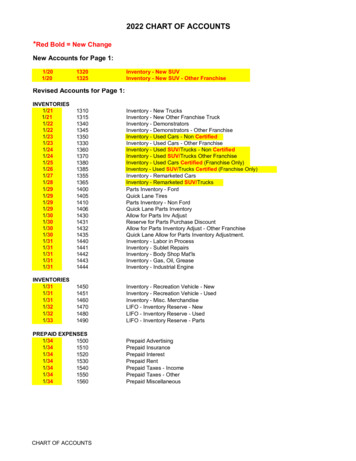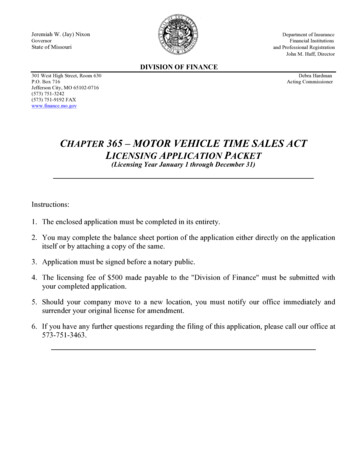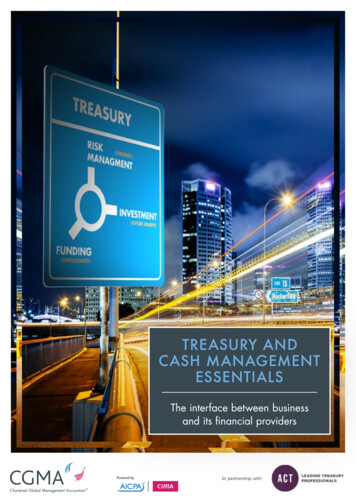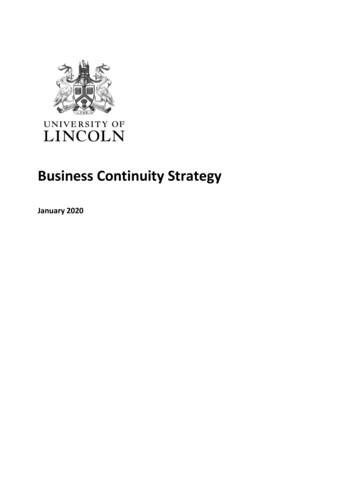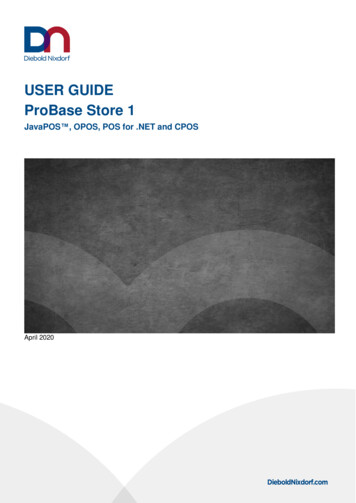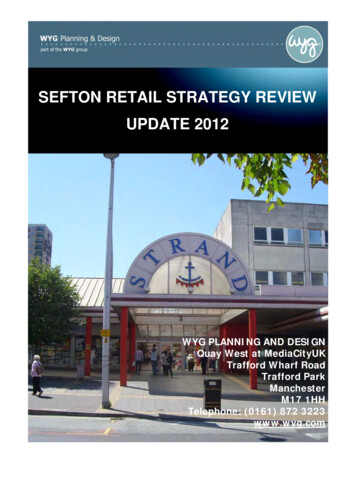
Transcription
SEFTON RETAIL STRATEGY REVIEWUPDATE 2012WYG PLANNING AND DESIGNQuay West at MediaCityUKTrafford Wharf RoadTrafford ParkManchesterM17 1HHTelephone: (0161) 872 3223www.wyg.com
Document ControlProject:Sefton Retail Strategy ReviewClient:Sefton MBCJob Number:A071115File Origin:T:\Job Files - Manchester\A071115 - Sefton Retail StrategyReview\Reports\Draft\Final 2009 RSR.docDocument Checking:Prepared by:Carly Hinde / Paul ShukerSigned:Checked by:Paul ShukerSigned:Verified by:Keith -2012Final Draft316-05-2012Final
Contents Page1.0INTRODUCTION. 12.0CURRENT AND EMERGING RETAIL TRENDS . 23.0PLANNING POLICY CONTEXT . 114.0SUMMARY OF THE VITALITY & VIABILITY OF KEY RETAIL CENTRES. 165.0ORIGINAL MARKET RESEARCH - UPDATE . 206.0POPULATION AND EXPENDITURE . 297.0RETAIL CAPACITY AND THE ROLE OF SEFTON TOWN CENTRES . 368.0SUMMARY AND CONCLUSIONS . 54Appendix ContentsAppendix 1 – Survey Zone PlansAppendix 2 – Household SurveyAppendix 3 – Bootle & Southport Health Check AssessmentsAppendix 4 – Capacity (Statistical) Tables
1.0 INTRODUCTIONObjectives of Study1.01WYG Planning & Design (WYG) was commissioned by Sefton Council to undertake an update of theprevious Sefton Retail Strategy Review (SRSR), which was prepared in October 2009.The 2009study was a partial update including a new retail model based on the household survey undertaken in2005 as part of the SRSR 2005 study. The 2012 study is now based on new empirical survey evidencewhich was commissioned to examine any changes in shopping patterns within the district since 2005.1.02For the purposes of this study, future retail ‘needs’ (based on population and expenditure) has beencalculated for the years 2011, 2016, 2021, 2026 and 2031 reflecting the five year time horizonsrecommended in the Practice Guidance accompanying Planning Policy Statement 4: Planning forSustainable Economic Growth (PPS4).1.03This report also updates the previous health checks undertaken for Southport and Bootle which areset out in Appendix 3.1.04As with the previous approach in 2005 and 2009, the report, examines future needs in relation to thetwo key town centres of Southport and Bootle. The network/hierarchy of centres is considered in moredetail in the District and Local Centres Study (2012).Structure of the Report1.05This report is structured as follows: Section 2 summarises current and emerging national retail trends and shopping patterns; Section 3 provides our review of the national, regional and local retail planning policy of relevanceto the study; Section 4 summarises our assessment of the current vitality and viability of the two key centres ofSouthport and Bootle; Section 5 considers the results of the household survey and sets out the key findings including anykey changes since 2005 across the Study Area; Section 6 considers current and future population and expenditure levels within the Study Area; Section 7 sets out our assessment of quantitative need for further convenience and comparisongoods floorspace in the periods to 2016, 2021, 2026 and 2031, taking into account claims onexpenditure growth; and Section 8 summarises our overall conclusions and recommendations.1Sefton Retail Strategy Review (RSR) 2011A07111516/05/2012
2.0 CURRENT AND EMERGING RETAIL TRENDSIntroduction2.01The retail property landscape across the UK has evolved significantly over the past 50 years, frompost-war redevelopment in town centres, through to the emergence of retail warehouse parks andout-of-town regional shopping malls.2.02During this time, the retail and leisure sectors have both experienced considerable expendituregrowth. Although this growth has been limited in more recent years, for most of the past decade ormore, spending on retail goods has increased significantly, particularly spending on comparison (ornon-food) goods. This expenditure growth has been attributable to a number of factors, includinggreater disposable income, cheaper prices, new technology and a general overall increase in ourstandard of living.2.03However, the retail market and the need for new development is continually changing as a result ofmany factors including demographics, consumer demands, car ownership, planning policy andtechnological advancements, such as e-tailing. These changes have had a subsequent impact on theformatand location ofretail andleisurefloorspace,general trend (morerecently)toexisting/established centres. This increase exemplifies the ‘town centre first’ policy approach whichhas been pursued by recent governments through national planning policy statements.Current Retail Picture2.04Research undertaken by Colliers CRE1 provides information on recent trends together with forecastsfor the future of retailing in the UK. The research confirms that the retail sector has been significantlyaffected by the economic climate and there is significant uncertainty about the strength and durabilityof future growth. It is noted that whilst sales volumes and footfall were high at the start of 2011,more recently, the retail market has declined. The significant reduction in government spending due tothe recent austerity measures and the increasing unemployment figures are clearly impacting onfuture economic growth.2.05These factors have had a significant impact on the public’s general confidence thereby reducing theirpropensity to spend their earnings on retail goods. Furthermore, recent and proposed increases in1‘Autumn 2011 Retail Report’, Colliers CRE, 20112Sefton Retail Strategy Review (RSR) 2011A07111516/05/2012
taxation (e.g. increases in VAT, national insurance contributions and capital gains tax) also suggestthat growth in household spending is unlikely to counterbalance any reduced public sector spending.Furthermore, inflation has risen to such a level that it is quickly outpacing average earnings growth byapproximately 2.5% (CBRE 2011).2.06The current economic conditions are resulting in significant structural changes to the high street,whereby many retailers are showing increased signs of caution by reducing the size of their propertyportfolios, abandoning their representation in weaker centres and concentrating on acquiring sites incity centres and major regional shopping centres. These steps have been taken by many well-knownhigh street operators (including Thorntons and Mothercare) and are identified as being necessary inorder to secure their future. Furthermore, comparison goods retailers are finding it increasinglydifficult to justify being represented in every town in the UK. Large cities and towns are likely tosuffer less compared to smaller centres, given that they offer a greater retail ‘experience’ andenhanced choice for customers and high volume trading potential for the retailers.2.07As a consequence of the above, demand has reduced considerably for ‘poorer quality premises’ insecondary locations and in many smaller towns with a commensurate drop in value (and often rent).Voids, nationally, have increased, resulting in a lack of investment in the upkeep of premises which insome cases is having a deleterious impact on the overall attractiveness certain centres or secondaryretail areas.In short, there has been a marked polarisation and divergence in retailer demand,characterised by diminishing demand for secondary premises in smaller locations and increasinginterest for well located and appropriately configured floorspace in key centres. Therefore, despite thedifficult economic conditions, rental values in prime locations are also expected to continue to rise,alongside increasing competition for space in key locations.2.08Given current spending patterns and the wider uncertain economic climate, it is unsurprising thatExperian, which monitors and forecasts retail consumer expenditure in the UK, has reviewed itsforecast growth rates for both convenience and comparison goods expenditure in recent years.Experian’s forecast annual per capita convenience goods growth rate2 is now -0.3% in 2011, -0.4% in2012 and 0.5% in 2013. This suggests that our spending on food is likely to decline slightly for thenext couple of years.However, forecast annual per capita comparison goods growth rates3 areslightly more positive than in previous years, with growth of 0.5% forecast in 2011, 1.6% forecast23Annual average per capita expenditure goods growth rates sourced from Experian Retail Planner Briefing Note 9, September 2011Ibid3Sefton Retail Strategy Review (RSR) 2011A07111516/05/2012
in 2012 and 2.1% forecast in 2013, after a single year of negative growth in 2009. Whilst this ismore encouraging, it is evident that these forecast growth rates are well below the figures beingrecorded prior to the economic downturn.2.09In line with Experian’s expectations, it has been widely reported that a number of high street retailerssuffered poor trading figures during 2009 and 2010, resulting in many operators selling heavilyreduced goods. Indeed, despite heavy discounting over the 2008 festive period and the reduction inVAT from 17.5% to 15.0% until January 2010, a significant number of ‘big name’ retailers went intoadministration in 2008 and 2009, including Woolworths, Adams and Zavvi.Whilst retailadministrations fell considerably in 20104, further high street brands affected last year include Envy,Ethel Austin, Habitat, Faith Shoes, Suits You.2.10Despite the difficulties outlined above, specific types of goods continue to perform well. The marketfor recreational goods (including DVDs, CDs, toys, computers and books) has, on the whole,performed well in recent years, with healthy growth attributed to supermarket sales together with thegrowing popularity of online shopping, which continues to see an increase in sales year-on-year.However, the increasing popularity of the internet to purchase, in particular, books and music has hada notable impact on the composition of town centres, with such stores (with the exception ofHMV/Waterstones – although they are reviewing their representation in certain centres) all butdisappearing from the high street.2.11As a direct consequence of wider economic conditions, Colliers CRE and Verdict5 research indicatesthat discount convenience retailers (including Lidl and Aldi) performed strongly during 2008 and 2009and sought to acquire additional sites which conform to their trading model (i.e. sites which willprovide for a single storey building in the order of 1,000 sq.m and around 100 car parking spaces).However, growth in this sector begun to slow in 2010 due to lower consumer sensitivity to price as theeconomy started to recover and due to a vigorous response from the ‘big four’ convenience goodsretailers (Asda, Morrisons, Sainsbury’s and Tesco) in the form of lower price promotions and additionalvalue lines. The influence of the sector has also been affected by Asda’s acquisition of Netto, whichwill result in the rebranding of around 150 such stores which started in the summer of 2011.45Reported by the ‘Who’s Gone Bust in Retailing 2010-11?’ Retail Briefing, Centre for Retail Research, March 2011‘UK Food & Grocery Retailers’, Verdict, September 20104Sefton Retail Strategy Review (RSR) 2011A07111516/05/2012
2.12At the other end of the market, Marks & Spencer Simply Food has not performed as strongly as it haspreviously, with additional food store openings acting to reduce food sales in its main store ‘foodhalls’. As a result, it was announced in January 20096 that 25 Simply Food stores were to close in theUK, following a two or three year period of rapid expansion. However, the ‘food hall’ offer will beexpanded as part of any new stores or store expansion throughout the UK.Trends in Comparison Goods Shopping2.13Whilst it is anticipated that growth in retail spending over the next ten years will not mirror that of thelast decade, there will continue to be some growth in comparison goods expenditure. Consequently,there is increasing impetus from retailers to achieve more efficient use of floorspace, particularly giventhe recent poor performance of certain national multiples, many of which have been affected by thesignificant increase in e-tailing (on line purchasing).As a consequence of the current economicclimate, retailers are more reluctant to commit to new development than they have been in previousdecades. Instead, they are more selective and are holding out for accommodation that is appropriateboth in terms of location and the type of premises provided. Indeed, retailers are seeking to occupylarger units in order to achieve more efficient use of floorspace and attract shoppers from a widerarea. These larger floorplates enable retailers to provide a greater range of goods.2.14International market conditions and price deflation in some key sectors has also meant that many highstreet names are becoming increasingly vulnerable to takeovers.Similarly, due to increasedcompetition there have been a number of high profile losses from the high street, including Habitat,Jane Norman and TJ Hughes which fell into administration in June 2011.Colliers7 reports thatconsolidation and cost reduction in relation to high street property continues to be a priority for mayretailers.This is being pursued through disposals, company voluntary administrations (CVAs),informal arrangements with landlords, lease expiries and break options. There has been an increase of55% in retailer failures from Q4 2010 (80) to Q1 2011 (124), with the number of CVAs also increasingby 30% over the same period.2.15More generally, whilst there is likely to be continued demand for larger, modern retail units in thefuture, increased sensitivity over future viability will mean a cautious approach to new investment formany key national retailers. Marginal locations within centres will increasingly be rejected. Manynational retailers, who would have previously considered smaller/lower order centres in order to67Reported by The Guardian, 7 January 2009‘Autumn 2011 Retail Report’, Colliers CRE, 20115Sefton Retail Strategy Review (RSR) 2011A07111516/05/2012
increase their market share, are now assessing the performance and their future strategies given theongoing downturn in the economy. Consequently, many investment decisions will be influenced bythe scale of commitment from other retailers; developers will increasingly need to promote large towncentre redevelopment schemes if they are to attract high quality retailers.Trends in Food Retailing2.16In the aftermath of the growth in the number of edge and out-of-centre large format supermarketsduring the 1990s, development of such facilities is now more limited due to stricter planning laws(following the publication of PPS6 and subsequently PPS4) and a lack of suitable sites. As a result, thenational multiples in the food retailing sector are finding a range of other measures to improve theirmarket share. These include:a. Offering a wider product range, such as financial and insurance products, petrol and non-foodgoods;b. Developing a wide range of retail models, for example small-format convenience stores in towncentres (e.g. Sainsbury’s Local, Tesco Express), smaller supermarkets mostly in town centres (e.g.Tesco Metro), superstores (e.g. Tesco) and hypermarkets (e.g. Tesco Extra, Asda Supercentres);c.Extended opening hours;d. Offering cheap products and no-frills service;e. Providing an attractive and powerful brand image; andf.2.17Offering a home delivery service.Verdict8 estimated that the food and grocery would be worth 130.0 billion in 2011, equating toannual growth of 3.2%, representing 43.7% of total retail spend. However, more subdued growth willbe entirely driven by lower inflation than that generally experienced in the sector in recent years.Whilst growth has therefore inevitably been impacted by the deteriorating economic climate, whichhas severely reduced household incomes, the estimated volume growth in the sector of 1.1% in 2010is the best since 2006.2.18Verdict identifies that the ‘credit crunch’ and subsequent recession – allied with a period of higherinflation – has had an impact on consumer behaviour and the wider dynamics of grocery retailing.Price, or specifically value, is now identified as the key issue for consumers and more and more8‘UK Food & Grocery Retailers’, Verdict, September 20116Sefton Retail Strategy Review (RSR) 2011A07111516/05/2012
shoppers are looking at value for money. Shoppers now realise that they are able to ‘trade down’ andswitch to own-label ranges to save money without sacrificing on quality.Indeed, customers aremixing value and premium in the same basket. Verdict reports that, as weekly food budgets fall andconsumers alter their shopping habits, growth will be limited and the battle for market share willintensify further. Winning a share of consumer spend will require more than low prices, with shoppersincreasingly seeking to source high-quality, good value food.2.19Verdict also states that food and grocery sector is being impacted by changing UK demographics. Forexample, there has been a rise in single occupancy young professional households who are ‘time poor’and relatively ‘cash rich’. Though their baskets might be small, they tend to buy higher value itemstherefore providing an opportunity to boost volume and value growth.Elsewhere, an ageingpopulation profile is leading to a rise in time rich consumers who are likely to do weekly shops ratherthan make frequent small trips. The contrasting requirements of these markets means that retailersare seeking both to add additional small stores to their portfolio and to open (and expand existing)larger stores.Verdict indicates that, as the race for space intensifies, format flexibility will beessential.2.20Between 2006 and 2010, grocery retailers’ total space increased by 5.3%, delivering an additional net6.0 million sq ft of new floorspace.The ‘Big Four’ (Asda, Morrisons, Tesco and Sainsbury’s) inparticular continue to seek out opportunities to provide additional floorspace, with Tesco (2.4 millionsq. ft) and Sainsbury’s (1.4 million sq. ft) reported by Verdict as having particularly aggressiveexpansion plans in 2010/11. Much of this additional floorspace was to be achieved through a focus onlarger format developments: Tesco was targeting the opening of 16 Extra stores over this period and181 new Express stores; Sainsbury’s has a pipeline of 15 to 20 new larger stores per year as it looksto stretch its portfolio by adding new space in superstores and hypermarkets to accommodate itsplans for a more extensive non-food product range.2.21The role of supermarkets continues to develop, with the large operators now offering a greaterdiversity of goods and services, via a larger number of formats and locations. Food and non-food salesare also increasing being driven by large supermarket growth, with half of town centres nowcompeting with five or more supermarkets within a two mile radius.9 Whilst the impact of newsupermarkets into an area is open to debate, it is evident, as noted by BCSC, that there has been asignificant decline in the number of independent food retailers, including a reduction of 45% of9‘What Does the future Hold for Town Centres?’, BCSC, September 20117Sefton Retail Strategy Review (RSR) 2011A07111516/05/2012
greengrocers between 1996 and 2007, whilst the market share of total retail sales of thesupermarkets has increased from 38% to 42% over the same period.2.22Following a period of strong performance in 2008 and 2009, as a result of greater consumer pricesensitivity and awareness of discounters’ offers, the sub-sector is now showing signs of slowing to itsprevious, much lower, rate of growth.In the UK, the hard discount sector has comprised threeoperators, these being Aldi, Lidl and Netto.However, following the purchase of the third largestoperator, Netto, by Asda in May 2010, the sector will now shrink significantly. Furthermore, lowerconsumer price sensitivity as the economy gradually recovers and a vigorous response from the ‘BigFour’ operators (through lower price promotions and value lines) has halted the defection ofcustomers to the discount sector.Out-of-Centre2.23Research undertaken by Colliers CRE notes that demand for out-of-centre representation is limited,with those retailers seeking to acquire stores having a pick of vacant stock which has been madeavailable through the administration of MFI, Land of Leather and Allied Carpets, amongst others.Some of the voids created by these administrations remain un-let and the flooding of the market withso much unwanted space has acted to reduce rents. Retailers who have had their pick of the beststores include Dunelm, Pets at Home, Dreams, Matalan, Dixons Group, Go Outdoors, Smyths Toys,B&M, Mothercare, Next Home and TK Maxx.2.24Looking forward, Colliers CRE indicates that the pipeline of retail warehouse development has almostdried up and that this, as demand for space picks up, will mean that the bottom has now passed forall but the weakest retail parks. Incentives for occupiers are currently reducing as a result and thatrental growth is likely to be commencing again in 2011/2012.Shopping Centre Development2.25Town centre retail development is at a virtual standstill and that little activity is anticipated over thenext few years. Viability is considered almost impossible to achieve no matter how well designed orwell located a scheme is.2.26Three types of scheme which may still be successful in the current challenging economic climate. Thefirst of these will be where a town has a large, affluent catchment and an acknowledged undersupplyof retail floorspace in both town centre and out-of-town locations. The second scenario relates toschemes which were very close to happening before the recession took hold, which may be revised to8Sefton Retail Strategy Review (RSR) 2011A07111516/05/2012
better meet the current needs of the market. Barnsley, Bradford and Lichfield are examples of suchschemes. The third opportunity relates to development where the key anchor is a foodstore and, as aresult, demand remains strong.2.27Proposed schemes which will conform to one of these models are considered to be few and farbetween and for development to begin again in earnest, it will be necessary for improvements inretailer demand, a strengthening of rental levels, further improvement into the investment marketand, critically, the availability of finance at viable levels. For those towns without an oversupply offloorspace and with sites which can be brought forward without excessive levels of cost, somedevelopment may be able to be brought forward within the next five years.However, suchopportunities may be the exception rather than the rule.Growth in E-tailing (‘E-commerce’)2.28Many consumers who previously shopped in town centres and at retail parks are now using theinternet for some of their purchases. This trend is set to continue, although the exact impact that ecommerce will have on the high street has yet to be fully established. However, the rise in the UK inrecent years of e-commerce has impacted upon retailers, developers and investors alike. As access tothe internet/online shopping continues to grow through digital televisions and mobile phones,proportionally less money is anticipated to be spent in the high street or at retail parks.2.29The growth in use of the internet as a sales medium has been enabled by increasing access to theinternet by households, rising from 61% in 2007 to 77% in 2011.10 The proportion of households withaccess to the internet is expected to increase further over the coming years, alongside the growth inmobile phone and tablets with internet access.This has supported the strong growth recorded,together with improved consumer confidence in the security of online payment, and heavy demand forexpensive electrical products available online. The option of using the internet to ‘click and collect’ instore is also increasing in popularity, with the service accounting for 20% of John Lewis internetorders.2.30Office for National Statistics (ONS) data11 indicates that the number of people using the internet topurchase goods continues to rise, with 66% of the UK population purchasing products over theinternet in 2011, compared to 53% at 2007. The most popular online purchases were clothes/sports1011‘Statistical Bulletin: Internet Access Households and Individuals’, Office for National Statistics, August 2011Ibid9Sefton Retail Strategy Review (RSR) 2011A07111516/05/2012
goods, with 46% of internet users buying these items. In addition, 21% of users bought food orgroceries and 38% bought household goods.2.31Additional research conducted by the Interactive Media in Retail Group (IMRG) and analystsCapgemini12 indicates that internet shopping equates to some 58.8 billion of expenditure, with Britishshoppers spending 5.2 billion online in August 2011, a year-on-year growth of 14%. The averagebasket value of online shoppers is 136 (2010), with IMRG identifying that the average annual onlinespend per shopper is 1,870.2.32The Top 10 e-retailers include Amazon UK, Argos, and Next. With regard to supermarket operators,Verdict’s research identifies that, with the exception of Morrisons (which does not trade online), majorretailers have seen their online business grow as online shopping has increased. As a result, the likesof Asda and Sainsbury’s have improved their geographical coverage and capacity.2.33It is evident that internet shopping as a whole is having an impact upon traditional high streets, inlight of increased competition and lower prices. Consequently, there is a possibility that online retailingwill put some pressure on retail rental growth over the next five to ten years. However, it will bedifficult to understand the true impact as the current economic downturn is also having a significantimpact on rental levels. Having said that, it would appear that the smaller the centre, the greater theimpact will be felt from online retailing. Within small shopping centres (sized between 5,000 sq.m and20,000 sq.m), including those in market towns, it is likely that the growth of online shopping couldreduce turnover notwithstanding any future growth in disposable income.2.34Despite all these different assumptions with regard to the future effect of online shopping, it isconsidered that e-tailing will not replace the shopping experience as shopping is a social activity. Forsuccessful retailers, online selling provides an additional route to the market. Online retailers benefitfrom demand generated through physical channels whilst high-street outlets can benefit from reachinga wider customer base through the internet. Clearly, those retailers who are likely to have a healthyfuture are those which combine a strong high street presence with an interesting and closely relatede-tail offer.12IMRG Capgemini e-retail Sales Index, 201110Sefton Retail Strategy Review (RSR) 2011A07111516/05/2012
3.0 PLANNING POLICY CONTEXTIntroduction3.01Given that this study seeks to provide important evidence to assist in the production of the LocalDevelopment Framework (LDF), it is important to review key policy advice and explore how currentand emerging national planning policy may impact upon the delivery of local policy.National Planning Policy Framework (NPPF)3.02The National Planning Policy Framework was published on 27th March 2012. The Framework replacesall former Planning Policy Statements, Planning Policy Guidance Notes and some Circulars with thissingle consolidated document.3.03The main theme of the Framework is that there should be ‘a presumption in favour of sustainabledevelopment’. In terms of plan-making it is stated that local planning authorities should positivelyseek opportunities to meet the development needs of their area, with an emphasis on Local Planshaving sufficient flexibility to adapt to rapid change.3.04In terms of economic development, it is set out within the NPPF’s core principles that planning shouldproactively drive and support economic development to deliver the homes, business and industrialunits, infrastructure and thriving local places that the country needs. It is emphasised that every effortshould be made to objectively identify and then meet the business and other development needs of anarea, with positive responses made to wider opportunities for growth.3.05The Framework stresses the Government’s commitment to securing economic growth in order tocreate jobs and prosperity, with the Government seeking to ensure that the planning system doeseverything it can to support sustainable economic growth. The need for planning to encourage andnot to act as an impediment to sustainable growth is stated and therefore it is prescribed thatsignificant weight should be placed on the need to support economic growth through the planningsystem. The NPPF seeks to ensure that local planning authorities plan proactively to meet thedevelopment needs of business and support an economy fit for the 21st century.3.06The NPPF still recognises the need to promote the vitality and viability of towns and cities through thepromotion of competition and growth management during the plan period. It also recognises thatretail activity should still, where possible, be focused in existing t
taxation (e.g. increases in VAT, national insurance contributions and capital gains tax) also suggest that growth in household spending is unlikely to counterbalance any reduced public sector spending. Furthermore, inflation has risen to such a level that it is quickly outpacing average earnings growth by approximately 2.5% (CBRE 2011).
